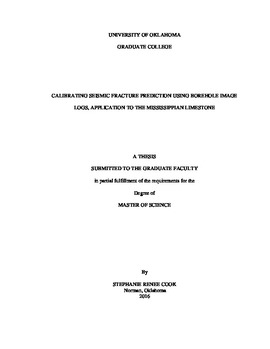| dc.description.abstract | The Mississippian Limestone of North Oklahoma and Southern Kansas has been one of the more active Midcontinent resource plays of the past decade, with over 4,300 horizontal wells drilled and completed between 2010 and 2015 (IHS). The Mississippian Limestone is a highly heterogeneous reservoir with deposits of not just limestone, but also tripolitic chert, fractured chert, and cherty limestone. The silica rich tripolitic chert found east of the Nemaha Ridge has also been a highly productive drilling target in small portions of the study area. These highly porous tripolitic chert mounds were formed during the early Pennsylvanian uplift with subaerial exposure and diagenetic alteration of the porosity. However, with sporadic vertical production from the more ubiquitous non-porous limestone, it became clear that fracturing is a major driver of production in this reservoir.
Seismic amplitude, attributes, and impedance are often used to map faults, folds, and areas of greater porosity. However, fractures are rarely seen on seismic data. In this thesis I develop a work flow to differentiate more fractured from less fractured areas of the reservoir from 3D surface seismic using five horizontal image logs. I use a sixth image log to validate my prediction.
The strike of fractures in the borehole images confirms the east-west compressional stress regime common to northern Oklahoma. With the uplift, subaerial exposure, and diagenetic alteration of the Mississippian Limestone in early Pennsylvanian time, karsting occurred and is prevalent throughout the area as well, with evidence of karsting interpreted in the borehole image logs.
Of the 18 attributes evaluated, envelope, density, variance, certain dip azimuth angles, frequency, and most negative long wavelength curvature correlated best with fracture intensity measured by the image logs. I used multivariate nonlinear regression statistics to use these attribute volumes to predict fractures throughout the survey. The resulting fracture intensity model shows increased fracturing in areas know to contain tripolitic chert, increased fracturing in areas of faulting, and increased fractures in areas with heavy karsting.
Correlating oil production with the resulting fracture intensity model is more problematic, with inclusion of variable production and engineering parameters necessary to make an accurate prediction. | en_US |
